Literature Review on Power Battery Echelon Reuse and Recycling from a Circular Economy Perspective
Abstract
1. Introduction
- (1)
- The recycling rate in some countries is relatively low.
- (2)
- Countries worldwide are exploring the echelon utilization of EoL power batteries. However, the specific application scenarios and implementation process need to be clearly delineated.
- (3)
- To guide remanufacturing enterprises toward a sustainable direction, policies for recycling EoL power batteries should be formulated from a systems perspective in some countries.
2. National Regulations for Recycling EoL Power Batteries
2.1. EU
2.2. US
2.3. Japan
2.4. China
2.5. Policy Comparison and Analysis
- (1)
- Some countries face low recycling rates, with China having a lower recycling rate for end-of-life (EoL) power batteries compared to other countries. High recycling rates are typically observed in nations that implement specific characteristics, i.e., (1) the establishment of regulations that govern enterprise behavior toward recycling EoL batteries; (2) the imposition of hefty fines for any violations; (3) the regulation of recycling processing fees, taxes, and deposit payments, which serves to oversee recycling enterprises and enforce consumer recycling obligations. However, in China, the recycling of rechargeable batteries is encouraged by charging consumers a fee for recycling treatment and providing subsidies. As a result, China has an imperfect and ineffective recycling system in comparison to several other countries, and most EoL power batteries have not been recycled through formal methods [53]. Countries with low recycling rates typically lack well-developed recycling systems and measures to monitor enterprises [29].
- (2)
- Currently, the policies of several countries prioritize the recycling and echelon utilization of power batteries, which are important for implementing sustainable development. The field of power battery echelon utilization is still in its early stages, and the policies introduced by various countries primarily focus on funding the R&D of enterprises in this field. The application scenarios for echelon utilization are rather vague, and there has yet to be a comprehensive and specific summary of them.
3. Existing Recycling Models
3.1. Existing Recycling Methods
3.1.1. Battery Manufacturer’s Recycling Model
3.1.2. NEV Enterprises Recycling Model
3.1.3. Industry Alliance Recycling Model
3.1.4. Third-Party Recycling Model
3.2. Existing Recycling Systems
3.2.1. Reducing
3.2.2. Reuse
3.2.3. Remanufacturing
3.2.4. Recycling
4. Echelon Utilization
4.1. Application Scenarios
4.1.1. Generation-Side Energy Storage
4.1.2. User-Side Energy Storage
4.1.3. Mobile Power Supply
4.2. Development Status and Trend
5. Proposed Trends in EoL Power Battery Recycling System from a Circular Economy Perspective
5.1. Theoretical Basis of the Recycle System
5.2. 4R EoL Power Battery Recycling System
6. Existing Problems and Recommendations
6.1. Existing Problems
Existing Policy Problems
6.2. Existing Technical Challenges
6.3. Recommendations
6.3.1. Government
- (1)
- According to the 4R EoL power battery recycling system, governments consider echelon utilization and clarify the responsibilities of recycling enterprises. To achieve the goals of environmental protection, resource conservation, and safe use, the government must also improve its policies and regulations, technical guidelines, evaluation standards, and industrial chain for echelon utilization.
- (2)
- The government should bolster oversight of EPR implementation by battery manufacturers and NEV manufacturers and improve the regulatory framework. In addition, the government should increase the penalties for companies that violate recycling laws.
- (3)
- The government establishes technology subsidies, focusing on subsidizing research and technological breakthroughs in critical echelon utilization applications. The government has increased support for recycling companies to promote the growth of the recycling power battery industry.
- (4)
- The government increased subsidies to consumers to incentivize consumer participation in recycling. The government and competitors should educate consumers about environmental awareness and formal recycling procedures.
- (5)
- The government rationalizes the planning of recycling infrastructures for power batteries. It may be convenient for consumers to return their power batteries at these locations and for enterprises to reduce transportation distances and reduce costs by replacing them at these locations.
6.3.2. Enterprises
- (1)
- Battery manufacturers, NEV manufacturers, NEV retailers, and hierarchical utilization enterprises must engage in collaborative design, management, and data sharing, and cooperate to address the issues of constructing battery recycling methods, building a recycling evaluation system for the entire life cycle, and establishing a service system. According to the four existing recycling methods, technology integration among enterprises will be strengthened, thus reducing investment risks and achieving win-win cooperation.
- (2)
- Battery manufacturers should increase their investments in recycling equipment, research, development, and technical personnel. They should establish a traceable power battery recycling regulatory system using blockchain technology to ensure real-time monitoring of companies’ implementation of full life cycle tracking. Enterprises should also enhance their awareness of recycling and improve their sense of corporate social responsibility.
- (3)
- NEV retailers should use advertising and education to increase consumer participation in battery recycling or promote “trade-in” activities to attract more consumers to participate in recycling. When the recycling volume reaches a particular scale, it can also increase the profit of the recycler. In addition, recycling companies should set reasonable prices to balance the interests of enterprises and consumers.
6.3.3. Consumers
7. Conclusions
- (1)
- This paper examines the battery recycling regulations of the EU, the U.S., Japan, and China. The government regulates countries with high recycling rates through legislation, deposit systems, high fines, and subsidies. Upon analyzing the policies, it was found that echelon utilization of EoL power batteries has become a significant concern in all nations.
- (2)
- This paper summarizes the four existing recycling “models”: battery manufacturers recycling model, NEV enterprises recycling model, the industry alliance recycling model, and the third-party recycling model. This paper summarizes the recycling systems in EoL power batteries, including reducing, reusing, remanufacturing, and recycling, by combining circular economy theory and closed-loop supply chain systems.
- (3)
- Combined with the development policy and recycling system, EoL power battery echelon utilization will be the focus of future development. However, several studies clearly delineate the application scenarios of echelon utilization. This paper presents the application scenarios of echelon utilization in terms of generation-side energy storage, user-side energy storage, and mobile power supply; we use actual cases for analysis.
- (4)
- The government must establish clear and effective recycling methods and normative recycling systems. Therefore, this paper proposes a 4R EoL power battery recycling system that accounts for echelon utilization and suggests the use of state of health (SOH) to assess the states to determine the recycling steps.
- (5)
- This paper analyzes the existing policy problems and technological challenges and proposes three aspects of development for the government, businesses, and consumers based on the above analysis.
Author Contributions
Funding
Institutional Review Board Statement
Informed Consent Statement
Data Availability Statement
Acknowledgments
Conflicts of Interest
References
- Liao, H.; Zhang, Q.; Li, L. Optimal procurement strategy for multi-echelon remanufacturing systems under quality uncertainty. Transp. Res. Part E Logist. Transp. Rev. 2018, 170, 103023. [Google Scholar] [CrossRef]
- Liu, F.; Zhao, F.; Liu, Z.; Hao, H. The impact of fuel cell vehicle deployment on road transport greenhouse gas emissions: The China case. Int. J. Hydrogen Energy 2018, 43, 22604–22621. [Google Scholar] [CrossRef]
- Zhao, F.; Liu, F.; Liu, Z.; Hao, H. The correlated impacts of fuel consumption improvements and vehicle electrification on vehicle greenhouse gas emissions in China. J. Clean. Prod. 2019, 207, 702–716. [Google Scholar] [CrossRef]
- Shen, N.; Liao, H.; Deng, R.; Wang, Q. Different Types of Environmental Regulations and the Heterogeneous Influence on the Environmental Total Factor Productivity: Empirical Analysis of China’s Industry. J. Clean. Prod. 2019, 211, 171–184. [Google Scholar] [CrossRef]
- Habib, K.; Hansdóttir, S.T.; Habib, H. Critical metals for electromobility: Global demand scenarios for passenger vehicles, 2015–2050. Resour. Conserv. Recycl. 2020, 154, 104603. [Google Scholar] [CrossRef]
- Liao, H.; Wu, D.; Wang, Y.; Lyu, Z.; Sun, H.; Nie, Y.; He, H. Impacts of carbon trading mechanism on closed-loop supply chain: A case study of stringer pallet remanufacturing. Socio-Econ. Plan. Sci. 2022, 81, 101209. [Google Scholar] [CrossRef]
- Vats, G.; Mathur, R. A net-zero emissions energy system in India by 2050: An exploration. J. Clean. Prod. 2022, 352, 131417. [Google Scholar] [CrossRef]
- Liao, H.; Zhang, Q.; Shen, N.; Nie, Y.; Li, L. Coordination between forward and reverse production streams for maximum profitability. Omega 2018, 104, 102454. [Google Scholar] [CrossRef]
- Liao, H.; Li, L. Environmental sustainability EOQ model for closed-loop supply chain under market uncertainty: A case study of printer remanufacturing. Comput. Ind. Eng. 2018, 151, 106525. [Google Scholar] [CrossRef]
- Chakraborty, S.; Kumar, N.M.; Jayakumar, A.; Dash, S.K.; Elangovan, D. Selected Aspects of Sustainable Mobility Reveals Implementable Approaches and Conceivable Actions. Sustainability 2021, 13, 12918. [Google Scholar] [CrossRef]
- Wang, J.; Wang, B.; Zhang, L.; Wang, J.; Shchurov, N.I.; Malozyomov, B.V. Review of Bidirectional DC-DC Converter Topologies for Hybrid Energy Storage System of New Energy Vehicles. Green Energy Intell. Transp. 2022, 1, 100010. [Google Scholar] [CrossRef]
- Liao, H.; Peng, S.; Li, L.; Zhu, Y. The role of governmental policy in game between traditional fuel and new energy vehicles. Comput. Ind. Eng. 2022, 169, 108292. [Google Scholar] [CrossRef]
- Xiong, S.; Ji, J.; Ma, X. Environmental and economic evaluation of remanufacturing lithium-ion batteries from electric vehicles. Waste Manag. 2020, 102, 579–586. [Google Scholar] [CrossRef]
- Wang, X.; Huang, L.; Daim, T.; Li, X.; Li, Z. Evaluation of China’s new energy vehicle policy texts with quantitative and qualitative analysis. Technol. Soc. 2021, 67, 101770. [Google Scholar] [CrossRef]
- Miao, Y.; Liu, L.; Zhang, Y.; Tan, Q.; Li, J. An overview of global power lithium-ion batteries and associated critical metal recycling. J. Hazard Mater. 2022, 425, 127900. [Google Scholar] [CrossRef]
- Zhili, D.; Boqiang, L.; Chunxu, G. Development path of electric vehicles in China under environmental and energy security constraints. Resour. Conserv. Recycl. 2019, 143, 17–26. [Google Scholar] [CrossRef]
- Kendall, M. Fuel cell development for New Energy Vehicles (NEVs) and clean air in China. Prog. Nat. Sci. Mater. Int. 2018, 28, 113–120. [Google Scholar] [CrossRef]
- Wang, W.; Wu, Y. An overview of recycling and treatment of spent LiFePO 4 batteries in China. Resour. Conserv. Recycl. 2017, 127, 233–243. [Google Scholar] [CrossRef]
- Ciez, R.E.; Whitacre, J.F. The cost of lithium is unlikely to upend the price of Li-ion storage systems. J. Power Sources 2016, 320, 310–313. [Google Scholar] [CrossRef]
- Olivetti, E.A.; Ceder, G.; Gaustad, G.G.; Fu, X. Lithium-Ion Battery Supply Chain Considerations: Analysis of Potential Bottlenecks in Critical Metals. Joule 2017, 1, 229–243. [Google Scholar] [CrossRef]
- Rallo, H.; Benveniste, G.; Gestoso, I.; Amante, B. Economic analysis of the disassembling activities to the reuse of electric vehicles Li-ion batteries. Resour. Conserv. Recycl. 2020, 159, 104785. [Google Scholar] [CrossRef]
- Malinauskaite, J.; Anguilano, L.; Rivera, X.S. Circular waste management of electric vehicle batteries: Legal and technical perspectives from the EU and the UK post Brexit. Int. J. Thermofluids 2021, 10, 100078. [Google Scholar] [CrossRef]
- Zhao, S.; Ma, C. Research on the coordination of the power battery echelon utilization supply chain considering recycling outsourcing. J. Clean. Prod. 2022, 358, 131922. [Google Scholar] [CrossRef]
- Neubauer, J.; Pesaran, A.; Williams, B.; Ferry, M.; Eyer, J. Techno-Economic Analysis of PEV Battery Second Use: Repurposed-Battery Selling Price and Commercial and Industrial End-User Value; Report 0148-7191; National Renewable Energy Laboratory (NREL): Golden, CO, USA, 2012.
- Hao, H.; Qiao, Q.; Liu, Z.; Zhao, F. Impact of recycling on energy consumption and greenhouse gas emissions from electric vehicle production: The China 2025 case. Resour. Conserv. Recycl. 2017, 122, 114–125. [Google Scholar] [CrossRef]
- Feng, T.; Guo, W.; Li, Q.; Meng, Z.; Liang, W. Life cycle assessment of lithium nickel cobalt manganese oxide batteries and lithium iron phosphate batteries for electric vehicles in China. J. Energy Storage 2022, 52, 104767. [Google Scholar] [CrossRef]
- Wang, Y.; Tang, B.; Shen, M.; Wu, Y.; Qu, S.; Hu, Y.; Feng, Y. Environmental impact assessment of second life and recycling for LiFePO4 power batteries in China. J. Environ. Manag. 2022, 314, 115083. [Google Scholar] [CrossRef]
- Mahmoudan, A.; Samadof, P.; Hosseinzadeh, S.; Garcia, D.A. A multigeneration cascade system using ground-source energy with cold recovery: 3E analyses and multi-objective optimization. Energy 2021, 233, 121185. [Google Scholar] [CrossRef]
- Turner, J.M.; Nugent, L.M. Charging up Battery Recycling Policies: Extended Producer Responsibility for Single-Use Batteries in the European Union, Canada, and the United States. J. Ind. Ecol. 2016, 20, 1148–1158. [Google Scholar] [CrossRef]
- Albertsen, L.; Richter, J.L.; Peck, P.; Dalhammar, C.; Plepys, A. Circular business models for electric vehicle lithium-ion batteries: An analysis of current practices of vehicle manufacturers and policies in the EU. Resour. Conserv. Recycl. 2021, 172, 105658. [Google Scholar] [CrossRef]
- Winslow, K.; Laux, S.; Townsend, T. A review on the growing concern and potential management strategies of waste lithium-ion batteries. Resour. Conserv. Recycl. 2018, 129, 263–277. [Google Scholar] [CrossRef]
- Costa, C.M.; Barbosa, J.C.; Gonçalves, R.; Castro, H.; Campo, F.J.D.; Lanceros-Méndez, S. Recycling and environmental issues of lithium-ion batteries: Advances, challenges and opportunities. Energy Storage Mater. 2021, 37, 433–465. [Google Scholar] [CrossRef]
- Viesi, D.; Crema, L.; Testi, M. The Italian hydrogen mobility scenario implementing the European directive on alternative fuels infrastructure (DAFI 2014/94/EU). Int. J. Hydrogen Energy 2017, 42, 27354–27373. [Google Scholar] [CrossRef]
- Hossain, E.; Murtaugh, D.; Mody, J.; Faruque, H.M.R.; Sunny, M.S.H.; Mohammad, N. A comprehensive review on second-life batteries: Current state, manufacturing considerations, applications, impacts, barriers & potential solutions, business strategies, and policies. IEEE Access 2019, 7, 73215–73252. [Google Scholar]
- Lai, X.; Chen, Q.; Tang, X.; Zhou, Y.; Gao, F.; Guo, Y.; Bhagat, R.; Zheng, Y. Critical review of life cycle assessment of lithium-ion batteries for electric vehicles: A lifespan perspective. eTransportation 2022, 12, 100169. [Google Scholar] [CrossRef]
- Allam, I.; Scagnelli, S.; Corazza, L. Sustainability reporting, a new type of companies’ hypocrisy: Zara and Volkswagen cases. In Responsible Business in a Changing World; Springer: Berlin/Heidelberg, Germany, 2020; pp. 195–211. [Google Scholar]
- Yu, J.; Wang, S.; Serrona, K.R.B. Comparative analysis of ELV recycling policies in the European Union, Japan and China. Investig. Linguist. 2019, 43, 34–56. [Google Scholar] [CrossRef]
- Bird, R.; Baum, Z.J.; Yu, X.; Ma, J. The regulatory environment for lithium-ion battery recycling. ACS Energy Lett. 2022, 7, 736–740. [Google Scholar] [CrossRef]
- Zhang, C.; Hu, M.; Laclau, B.; Garnesson, T.; Yang, X.; Tukker, A. Energy-carbon-investment payback analysis of prefabricated envelope-cladding system for building energy renovation: Cases in Spain, the Netherlands, and Sweden. Renew. Sustain. Energy Rev. 2021, 145, 111077. [Google Scholar] [CrossRef]
- Chen, H.; Zhang, T.; Gao, Q.; Han, Z.; Jin, Y.; Li, L.; Yang, K.; Xu, Y.; Liu, X.; Xu, X.; et al. Assessment and management of health status in full life cycle of echelon utilization for retired power lithium batteries. J. Clean. Prod. 2022, 379, 134583. [Google Scholar] [CrossRef]
- Hu, Y. A study on the legal regulation of negative externalities of battery consumption. Trib. Econ. Law 2012, 9, 105–114. (In Chinese) [Google Scholar]
- Honma, S.; Hu, J.L. Cost efficiency of recycling and waste disposal in Japan. J. Clean. Prod. 2021, 284, 125274. [Google Scholar] [CrossRef]
- Lai, X.; Huang, Y.; Deng, C.; Gu, H.; Han, X.; Zheng, Y.; Ouyang, M. Sorting, regrouping, and echelon utilization of the large-scale retired lithium batteries: A critical review. Renew. Sustain. Energy Rev. 2021, 146, 111162. [Google Scholar] [CrossRef]
- Asari, M.; Sakai, S.I. Li-ion battery recycling and cobalt flow analysis in Japan. Resour. Conserv. Recycl. 2013, 81, 52–59. [Google Scholar] [CrossRef]
- Zhao, Q.; Chen, M. A comparison of ELV recycling system in China and Japan and China’s strategies. Resour. Conserv. Recycl. 2011, 57, 15–21. [Google Scholar] [CrossRef]
- Wang, S.; Yu, J.; Okubo, K. Life cycle assessment on the reuse and recycling of the nickel-metal hydride battery: Fleet-based study on hybrid vehicle batteries from Japan. J. Ind. Ecol. 2021, 25, 1236–1249. [Google Scholar] [CrossRef]
- Azadnia, A.H.; Onofrei, G.; Ghadimi, P. Electric vehicles lithium-ion batteries reverse logistics implementation barriers analysis: A TISM-MICMAC approach. Resour. Conserv. Recycl. 2021, 174, 105751. [Google Scholar] [CrossRef]
- Sun, S.; Jin, C.; He, W.; Li, G.; Zhu, H.; Huang, J. Management status of waste lithium-ion batteries in China and a complete closed-circuit recycling process. Sci. Total Environ. 2021, 776, 145913. [Google Scholar] [CrossRef]
- Mancha, A. A look at some international lithium ion battery recycling initiatives. Undergrad. Res. Univ. Ill. Chic. 2016, 9. [Google Scholar] [CrossRef]
- Tang, Y.; Zhang, Q.; Li, Y.; Li, H.; Pan, X.; McLellan, B. The social-economic-environmental impacts of recycling retired EV batteries under reward-penalty mechanism. Appl. Energy 2019, 251, 113313. [Google Scholar] [CrossRef]
- Zhang, H.; Huang, J.; Hu, R.; Zhou, D.; Khan, H.U.R.; Ma, C. Echelon utilization of waste power batteries in new energy vehicles: Review of Chinese policies. Energy 2020, 206, 118178. [Google Scholar] [CrossRef]
- Zhang, Q.; Tang, Y.; Bunn, D.; Li, H.; Li, Y. Comparative evaluation and policy analysis for recycling retired EV batteries with different collection modes. Appl. Energy 2021, 303, 117614. [Google Scholar] [CrossRef]
- Chen, S.; Chen, M.; Shu, J.; Deng, Y. Comparative analysis of recycling modes of power batteries based on extended producer-responsibility principle. Circ. Econ. 2022, 1, 100013. [Google Scholar] [CrossRef]
- Antoci, A.; Borghesi, S.; Galeotti, M.; Russu, P. Maladaptation to environmental degradation and the interplay between negative and positive externalities. Eur. Econ. Rev. 2022, 143, 104023. [Google Scholar] [CrossRef]
- Yu, W.; Guo, Y.; Shang, Z.; Zhang, Y.; Xu, S. A review on comprehensive recycling of spent power lithium-ion battery in China. eTransportation 2022, 11, 100155. [Google Scholar] [CrossRef]
- Gaines, L. Lithium-ion battery recycling processes: Research towards a sustainable course. Sustain. Mater. Technol. 2018, 17, e00068. [Google Scholar] [CrossRef]
- Spicer, A.J.; Johnson, M.R. Third-party demanufacturing as a solution for extended producer responsibility. J. Clean. Prod. 2004, 12, 37–45. [Google Scholar] [CrossRef]
- Zeff, S. My Electric Journey with a Nissan Leaf A classic early-adopter experience. IEEE Consum. Electron. Mag. 2016, 5, 79–84. [Google Scholar] [CrossRef]
- Call2Recycle. Powering Through. Powering Forward. 2020 Annual Report; Call2Recycle: Atlanta, GA, USA, 2021. [Google Scholar]
- Call2Recycle. Call2Recycle Releases 2021 U.S. Battery Collection Data; Call2Recycle: Atlanta, GA, USA, 2022. [Google Scholar]
- Rebitzer, G.; K6hler, A.; Suh, S. Theory and Practical Implementation of Life Cycle Assessment. In Proceedings of the 13th SETAC-Europe Annual Meeting, Hamburg, Germany, 27 April–1 May 2003; Volume 8, pp. 235–240. [Google Scholar]
- Stefanakis, A.I.; Calheiros, C.S.; Nikolaou, I. Nature-based solutions as a tool in the new circular economic model for climate change adaptation. Circ. Econ. Sustain. 2021, 1, 303–318. [Google Scholar] [CrossRef]
- Kirchherr, J.; Reike, D.; Hekkert, M. Conceptualizing the circular economy: An analysis of 114 definitions. Resour. Conserv. Recycl. 2017, 127, 221–232. [Google Scholar] [CrossRef]
- Liao, H.; Li, C.; Nie, Y.; Tan, J.; Liu, K. Environmental efficiency assessment for remanufacture of end of life machine and multi-objective optimization under carbon trading mechanism. J. Clean. Prod. 2021, 308, 127168. [Google Scholar] [CrossRef]
- Serna-Guerrero, R.; Ikonen, S.; Kallela, O.; Hakanen, E. Overcoming data gaps for an efficient circular economy: A case study on the battery materials ecosystem. J. Clean. Prod. 2022, 374, 133984. [Google Scholar] [CrossRef]
- Philippot, M.; Costa, D.; Hosen, M.S.; Senécat, A.; Brouwers, E.; Nanini-Maury, E.; Van Mierlo, J.; Messagie, M. Environmental impact of the second life of an automotive battery: Reuse and repurpose based on ageing tests. J. Clean. Prod. 2022, 366, 132872. [Google Scholar] [CrossRef]
- Alamerew, Y.A.; Brissaud, D. Modelling reverse supply chain through system dynamics for realizing the transition towards the circular economy: A case study on electric vehicle batteries. J. Clean. Prod. 2020, 254, 120025. [Google Scholar] [CrossRef]
- Standridge, C.; Hasan, M. Post-vehicle-application lithium-ion battery remanufacturing, repurposing and recycling capacity: Modeling and analysis. J. Ind. Eng. Manag. 2015, 8, 823–839. [Google Scholar] [CrossRef]
- Zhao, P.; Deng, Q.; Zhou, J.; Han, W.; Gong, G.; Jiang, C. Optimal production decisions for remanufacturing end-of-life products under quality uncertainty and a carbon cap-and-trade policy. Comput. Ind. Eng. 2021, 162, 107646. [Google Scholar] [CrossRef]
- Hua, Y.; Liu, X.; Zhou, S.; Huang, Y.; Ling, H.; Yang, S. Toward Sustainable Reuse of Retired Lithium-ion Batteries from Electric Vehicles. Resour. Conserv. Recycl. 2021, 168, 105249. [Google Scholar] [CrossRef]
- Hua, Y.; Zhou, S.; Huang, Y.; Liu, X.; Ling, H.; Zhou, X.; Zhang, C.; Yang, S. Sustainable value chain of retired lithium-ion batteries for electric vehicles. J. Power Sources 2020, 478, 228753. [Google Scholar] [CrossRef]
- Zhang, X.; Ao, X.; Cai, W.; Jiang, Z.; Zhang, H. A sustainability evaluation method integrating the energy, economic and environment in remanufacturing systems. J. Clean. Prod. 2019, 239, 118100. [Google Scholar] [CrossRef]
- Foster, M.; Isely, P.; Standridge, C.; Hasan, M. Feasibility assessment of remanufacturing, repurposing, and recycling of end of vehicle application lithium-ion batteries. J. Ind. Eng. Manag. 2014, 7, 698–715. [Google Scholar] [CrossRef]
- Sommerville, R.; Zhu, P.; Rajaeifar, M.A.; Heidrich, O.; Goodship, V.; Kendrick, E. A qualitative assessment of lithium ion battery recycling processes. Resour. Conserv. Recycl. 2021, 165, 105219. [Google Scholar] [CrossRef]
- Ma, H.; Deng, Y.; Liu, W.w.; Li, T.; Zhang, H. State of health estimation of retired battery for echelon utilization based on charging curve. Procedia CIRP 2022, 105, 458–463. [Google Scholar] [CrossRef]
- Xu, X.L.; Mi, J.F.; Fan, M.S.; Yang, K.; Wang, H.; Liu, J.B.; Yan, H. Study on the performance evaluation and echelon utilization of retired LiFePO(4)power battery for smart grid. J. Clean. Prod. 2019, 213, 1080–1086. [Google Scholar] [CrossRef]
- Koohi-Fayegh, S.; Rosen, M.A. A review of energy storage types, applications and recent developments. J. Energy Storage 2020, 27, 101047. [Google Scholar] [CrossRef]
- Hall, P.J.; Bain, E.J. Energy-storage technologies and electricity generation. Energy Policy 2008, 36, 4352–4355. [Google Scholar] [CrossRef]
- Liu, C.C.; Huang, S.T.; Fu, Z.G.; Li, C.; Tao, Y.B.; Tang, H.B.; Liao, Q.Q.; Wang, Z.Q. Recycling and Echelon Utilization of Used Lithium-Ion Batteries from Electric Vehicles in China. Int. J. Electrochem. Sci. 2022, 17, 19. [Google Scholar] [CrossRef]
- Rubenbauer, H.; Henninger, S. Definitions and reference values for battery systems in electrical power grids. J. Energy Storage 2017, 12, 87–107. [Google Scholar] [CrossRef]
- Hou, J.; Shao, Y.; Ellis, M.W.; Moore, R.B.; Yi, B. Graphene-based electrochemical energy conversion and storage: Fuel cells, supercapacitors and lithium ion batteries. Phys. Chem. Chem. Phys. 2011, 13, 15384. [Google Scholar] [CrossRef]
- Jin, Z.G. Reuse and Recycling of Lithium-Ion Power Batteries; John Wiley & Sons: New York, NY, USA, 2017. [Google Scholar]
- Ambrose, H.; Gershenson, D.; Gershenson, A.; Kammen, D. Driving rural energy access: A second-life application for electric-vehicle batteries. Environ. Res. Lett. 2014, 9, 094004. [Google Scholar] [CrossRef]
- Lai, X.; Huang, Y.; Gu, H.; Deng, C.; Han, X.; Feng, X.; Zheng, Y. Turning waste into wealth: A systematic review on echelon utilization and material recycling of retired lithium-ion batteries. Energy Storage Mater. 2021, 40, 96–123. [Google Scholar] [CrossRef]
- Heymans, C.; Walker, S.B.; Young, S.B.; Fowler, M. Economic analysis of second use electric vehicle batteries for residential energy storage and load-levelling. Energy Policy 2014, 71, 22–30. [Google Scholar] [CrossRef]
- Okou, R.; Sebitosi, A.B.; Khan, M.A.; Barendse, P.; Pillay, P. Design and Analysis of an Electromechanical Battery for Rural Electrification in Sub-Saharan Africa. IEEE Trans. Energy Convers. 2011, 26, 1198–1209. [Google Scholar] [CrossRef]
- Dong, Q.; Tan, Q.; Hao, S.; Li, J.; Liu, J. Analysis of power battery recycling mode and economy of new energy vehicles in Beijing. Sci. Technol. Manag. Res. 2020, 40, 7. (In Chinese) [Google Scholar]
- Zhang, Y.; Zhou, C.G.; Yang, J.; Xue, S.C.; Gao, H.L.; Yan, X.H.; Huo, Q.Y.; Wang, S.W.; Cao, Y.; Yan, J.; et al. Advances and challenges in improvement of the electrochemical performance for lead–acid batteries: A comprehensive review. J. Power Sources 2022, 520, 230800. [Google Scholar] [CrossRef]
- Wen, J.; Chen, X.; Li, X.; Li, Y. SOH prediction of lithium battery based on IC curve feature and BP neural network. Energy 2022, 261, 125234. [Google Scholar] [CrossRef]
- Wen, J.; Zou, Q.; Chen, C.; Wei, Y. Linear correlation between state-of-health and incremental state-of-charge in Li-ion batteries and its application to SoH evaluation. Electrochim. Acta 2022, 434, 141300. [Google Scholar] [CrossRef]
- Bobba, S.; Mathieux, F.; Blengini, G.A. How will second-use of batteries affect stocks and flows in the EU? A model for traction Li-ion batteries. Resour. Conserv. Recycl. 2019, 145, 279–291. [Google Scholar] [CrossRef]
- Neubauer, J.; Pesaran, A. The ability of battery second use strategies to impact plug-in electric vehicle prices and serve utility energy storage applications. J. Power Sources 2011, 196, 10351–10358. [Google Scholar] [CrossRef]
- Basia, A.; Simeu-Abazi, Z.; Gascard, E.; Zwolinski, P. Review on State of Health estimation methodologies for lithium-ion batteries in the context of circular economy. CIRP J. Manuf. Sci. Technol. 2021, 32, 517–528. [Google Scholar] [CrossRef]
- Zong-You, H.; Pang-Yen, L.; Wang, C.C. State of charge, state of health, and state of function monitoring for EV BMS. In Proceedings of the 2017 IEEE International Conference on Consumer Electronics (ICCE), Las Vegas, NV, USA, 8–10 January 2017; pp. 310–311. [Google Scholar] [CrossRef]
- Yang, S.; Zhang, C.; Jiang, J.; Zhang, W.; Zhang, L.; Wang, Y. Review on state-of-health of lithium-ion batteries: Characterizations, estimations and applications. J. Clean. Prod. 2021, 314, 128015. [Google Scholar] [CrossRef]
- Wang, L.; Wang, X.; Yang, W. Optimal design of electric vehicle battery recycling network – From the perspective of electric vehicle manufacturers. Appl. Energy 2020, 275, 115328. [Google Scholar] [CrossRef]
- Drabik, E.; Rizos, V. Prospects for Electric Vehicle Batteries in a Circular Economy; CEPS Research Report; CEPS: Sacramento, CA, USA, 2018. [Google Scholar]
- Govindan, K.; Bouzon, M. From a literature review to a multi-perspective framework for reverse logistics barriers and drivers. J. Clean. Prod. 2018, 187, 318–337. [Google Scholar] [CrossRef]
- Sun, Q.; Chen, H.; Long, R.; Li, Q.; Huang, H. Comparative evaluation for recycling waste power batteries with different collection modes based on Stackelberg game. J. Environ. Manag. 2022, 312, 114892. [Google Scholar] [CrossRef] [PubMed]
- Hong, X.; Xu, L.; Du, P.; Wang, W. Joint advertising, pricing and collection decisions in a closed-loop supply chain. Int. J. Prod. Econ. 2015, 167, 12–22. [Google Scholar] [CrossRef]
- Khorshidvand, B.; Soleimani, H.; Sibdari, S.; Mehdi Seyyed Esfahani, M. A hybrid modeling approach for green and sustainable closed-loop supply chain considering price, advertisement and uncertain demands. Comput. Ind. Eng. 2021, 157, 107326. [Google Scholar] [CrossRef]
- Harper, G.; Sommerville, R.; Kendrick, E.; Driscoll, L.; Slater, P.; Stolkin, R.; Walton, A.; Christensen, P.; Heidrich, O.; Lambert, S.; et al. Recycling lithium-ion batteries from electric vehicles. Nature 2019, 575, 75–86. [Google Scholar] [CrossRef]
- Wang, M.; Liu, K.; Dutta, S.; Alessi, D.S.; Rinklebe, J.; Ok, Y.S.; Tsang, D.C.W. Recycling of lithium iron phosphate batteries: StatU.S., technologies, challenges, and prospects. Renew. Sustain. Energy Rev. 2022, 163, 112515. [Google Scholar] [CrossRef]
- Brinkman, W.S. The social impacts of mining on local communities in Australia. Rural Society 2018, 27, 18–34. [Google Scholar]
- Banza Lubaba Nkulu, C.; Casas, L.; Haufroid, V.; De Putter, T.; Saenen, N.D.; Kayembe-Kitenge, T.; Musa Obadia, P.; Kyanika Wa Mukoma, D.; Lunda Ilunga, J.M.; Nawrot, T.S.; et al. Sustainability of artisanal mining of cobalt in DR Congo. Nat. Sustain. 2018, 1, 495–504. [Google Scholar] [CrossRef]
- Beaudet, A.; Larouche, F.; Amouzegar, K.; Bouchard, P.; Zaghib, K. Key Challenges and Opportunities for Recycling Electric Vehicle Battery Materials. Sustainability 2020, 12, 5837. [Google Scholar] [CrossRef]
- Salim, H.K.; Stewart, R.A.; Sahin, O.; Dudley, M. End-of-life management of solar photovoltaic and battery energy storage systems: A stakeholder survey in Australia. Resour. Conserv. Recycl. 2019, 150, 104444. [Google Scholar] [CrossRef]
- Shan, S.; Genç, S.Y.; Kamran, H.W.; Dinca, G. Role of green technology innovation and renewable energy in carbon neutrality: A sustainable investigation from Turkey. J. Environ. Manag. 2021, 294, 113004. [Google Scholar] [CrossRef]
- Wang, X.; Gaustad, G.; Babbitt, C.W.; Richa, K. Economies of scale for future lithium-ion battery recycling infrastructure. Resour. Conserv. Recycl. 2014, 83, 53–62. [Google Scholar] [CrossRef]
- Gaines, L. Profitable Recycling of Low-Cobalt Lithium-Ion Batteries Will Depend on New Process Developments. One Earth 2019, 1, 413–415. [Google Scholar] [CrossRef]

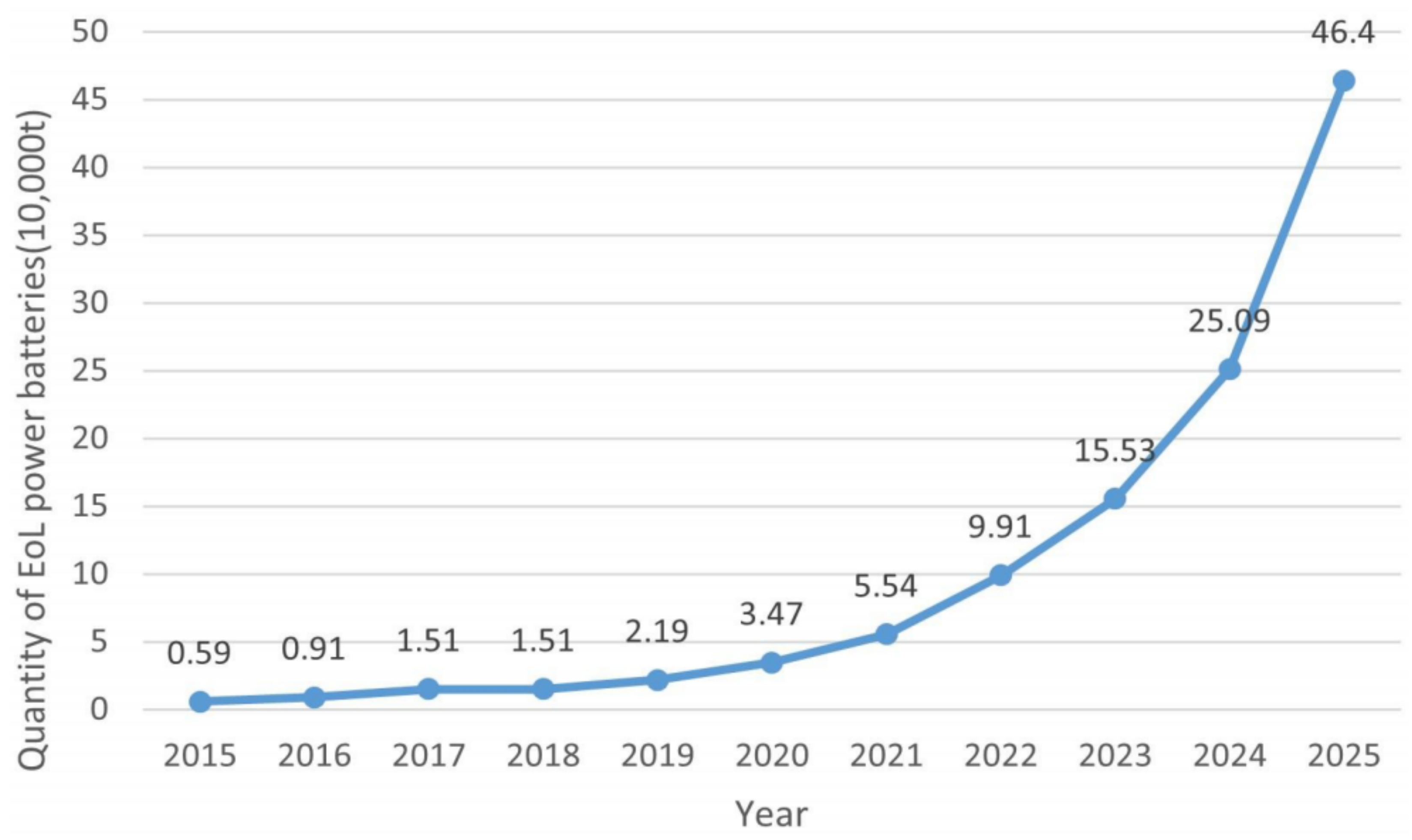
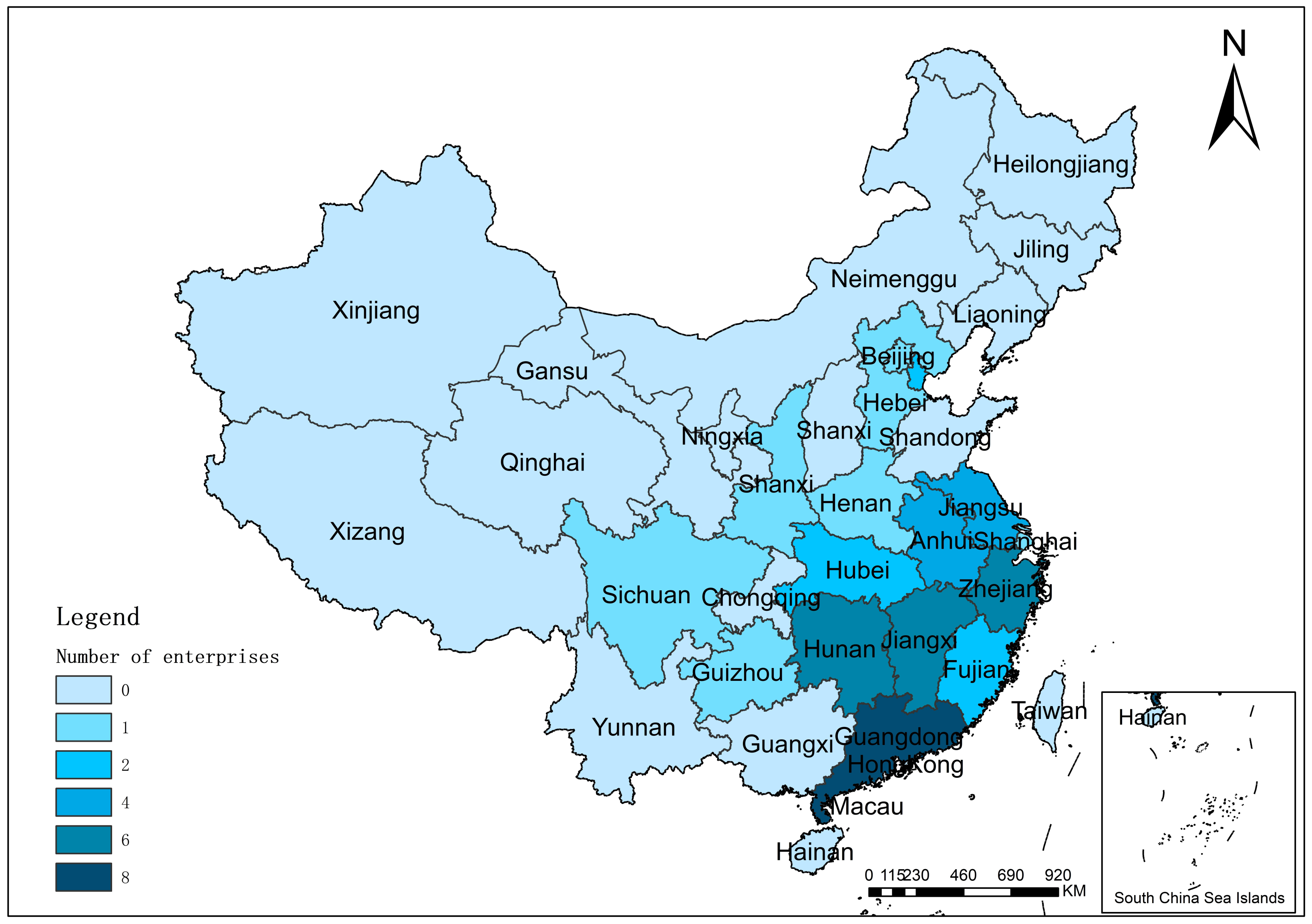
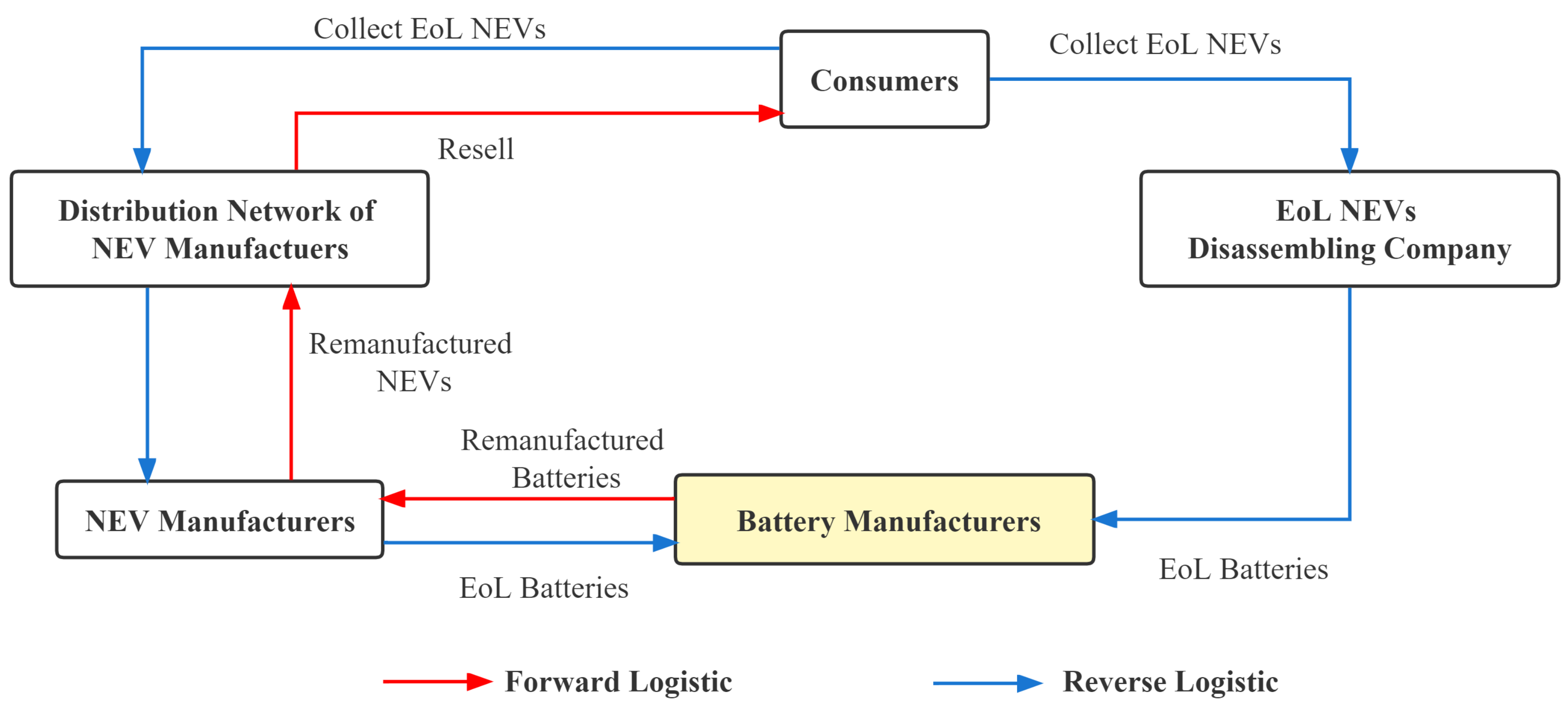
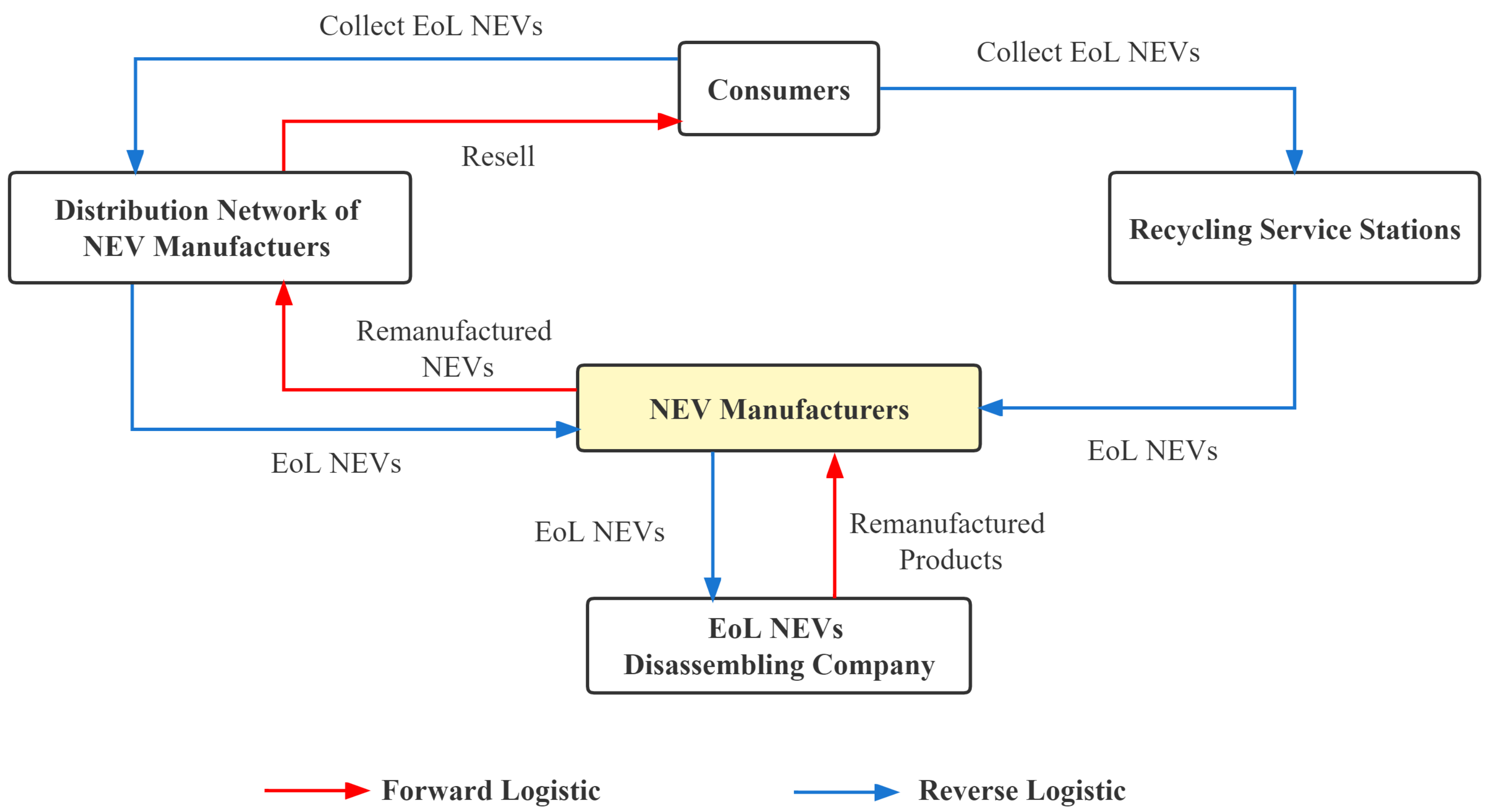
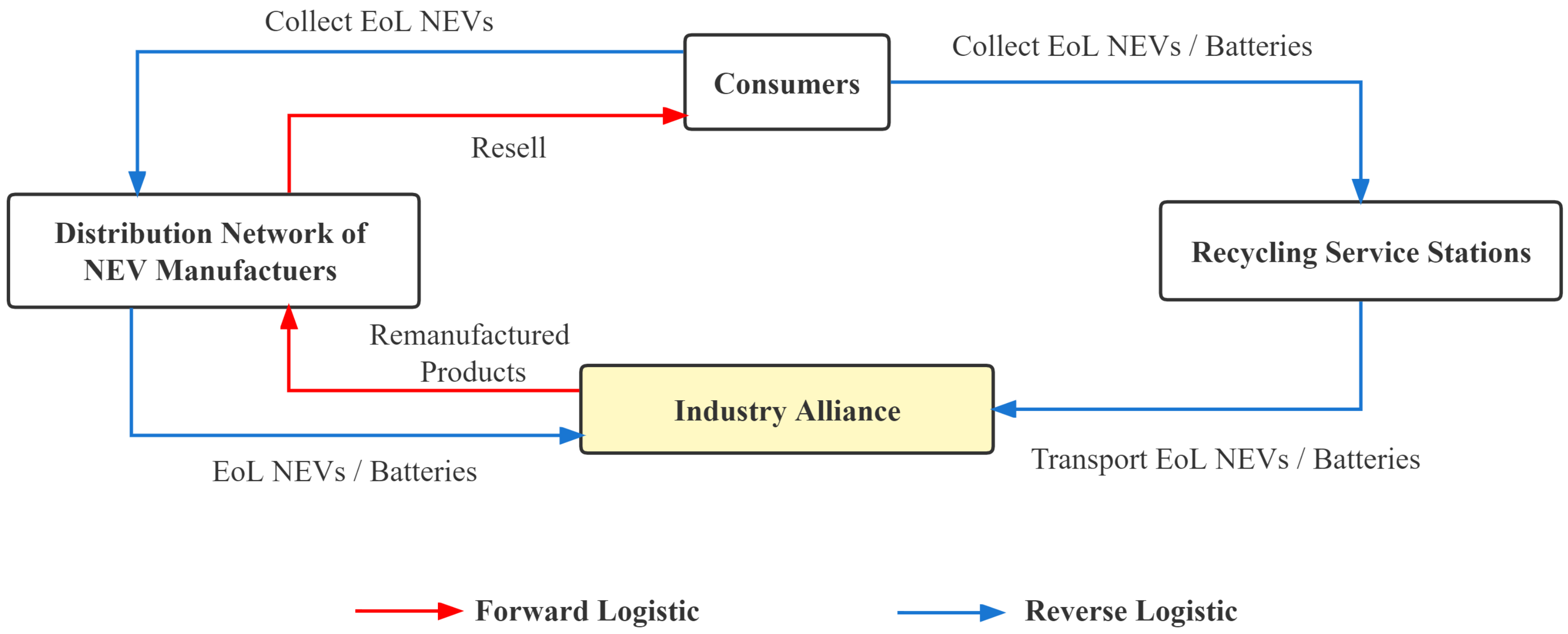

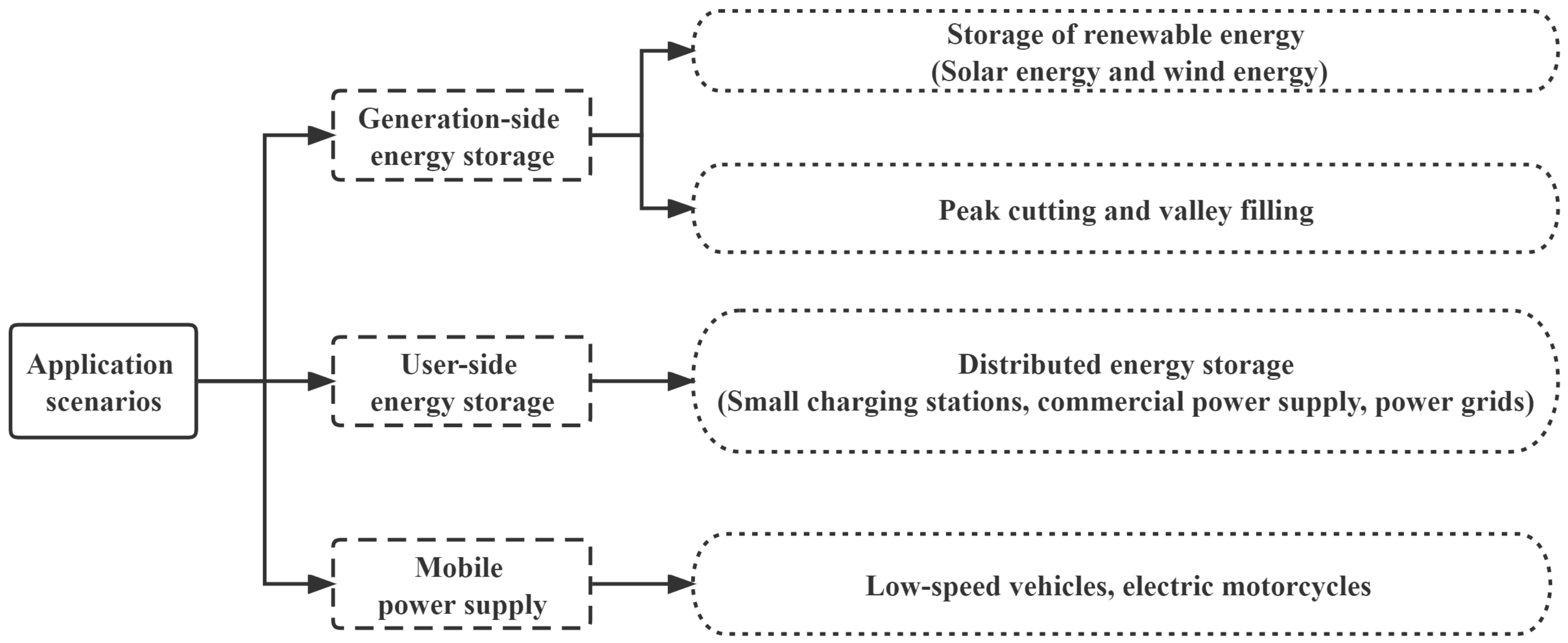
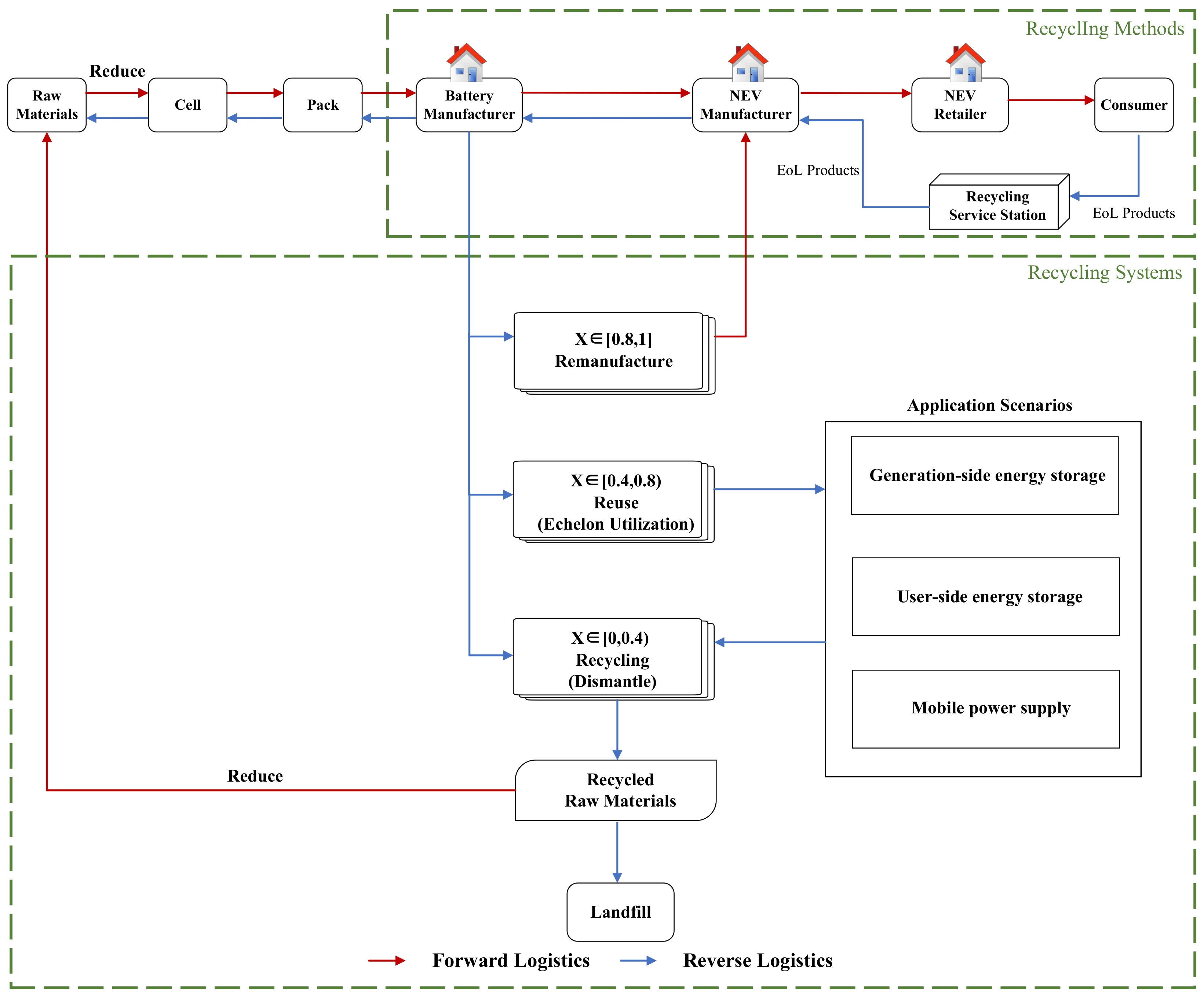
| Attributes of Different Policies | ||
|---|---|---|
| Date | Name | Key Points of Policy |
| Mar 1991 | Council Directive 91/157/EEC | Regulation of the mercury content in batteries. |
| Sept 2000 | End of Life Vehicle Directive 2000/53/EC | Reduce waste from vehicle scrapping and increase the recycling rate of EoL vehicles. Recycling costs are mainly paid by the manufacturers. |
| Sept 2006 | Battery Directive 2006/66/EC | Battery manufacturers establish EoL battery recycling systems, increase the recycling of EoL battery products, and improve the treatment and recycling rate of EoL batteries. |
| Dec 2013 | Battery Directive 2013/56/EU | Clarify the requirements for hazardous substance content, recycling labels, and hazardous substance labels. |
| Dec 2020 | New Battery Regulation 2020/0353 (COD) | Waste Battery Directive 2006/66/EC, focusing on the whole life cycle treatment of EoL batteries. |
| Attributes of Different Policies | |||
|---|---|---|---|
| Date | Name | Ministry | Key Points of Policy |
| Oct 1976 | Resource Conservation and Recovery Act | EPA | Amends the Solid Waste Disposal Act enacted in 1965 and proposes a basic framework for hazardous waste management. |
| May 1996 | Mercury-Containing and Rechargeable Battery Management Act | EPA | Supports the collection and recycling of rechargeable batteries containing heavy metals such as lead and cadmium. |
| Jun 2021 | National Lithium Development Blueprint 2021–-2030 | DOE | Analyzes the current development status and prospects of the U.S. lithium industry and proposes the construction goals of the lithium battery supply chain. |
| Feb 2022 | Battery Materials Processing and Battery Manufacturing Funding Opportunity Announcement (DE-FOA-0002677) | DOE | Provides approximately USD 2.8 billion to fund R&D in EV battery material processing and battery component manufacturing and recycling. |
| Feb 2022 | Electric Drive Vehicle Battery Recycling and Second-Life Applications (DOE-FOA-0002679) | DOE | Provides approximately USD 60 million to fund research and development, testing of EV battery recycling, stepping-up, reusing to scale, and profitability. |
| Attributes of Different Policies | ||
|---|---|---|
| Date | Name | Key Points of Policy |
| 2000 | The Basic Law for Establishing the Recycling-based Society | Establish the basic principles of waste and recycling policy. |
| 2002 | The Law for the Promotion of Effective Resource Utilization | Specify the product producer’s responsibility and recycling system construction and other requirements and emphasize the recycling of resources. |
| 2003 | The Law for the Recycling of End-of-life Vehicles | Clarify the cost of end-of-life vehicle treatment specifications and resource recovery and reuse. |
| Attributes of Different Policies | |||
|---|---|---|---|
| Date | Name | Ministry | Key Points of Policy |
| Feb 2006 | Technical policy on recycling and utilization of automobile products | NDRC | The first policy of recycling scrap auto parts based on the EPR system puts forward three-phased goals for vehicle product recycling and utilization. |
| Aug 2008 | Circular Economy Promotion Law | CPG | Dismantling or reusing waste lead–acid batteries should comply with the law. |
| Jan 2016 | Technical Policy on Electric Vehicle Power Battery Recycling (2015 Version) | NDRC | Guides the orderly recycling and utilization of EV power batteries, promotes resource regeneration, and puts EPR into effect. |
| Feb 2018 | Interim Measures for the Management of New Energy Vehicle Power Battery Recycling | MIIT | NEV manufacturers must implement the EPR system and assume primary responsibility for recycling batteries. They must adhere to the battery’s life cycle concept and the principle of the organic unity of environmental, social, and economic benefits. They must Ensure that the battery can be effectively recycled and treated environmentally responsibly. |
| Jul 2018 | Interim Regulations on Traceability Management of New Energy Vehicle Power Battery Recycling | MIIT | Establish a comprehensive management platform for power battery recycling and carrying out information collection and responsibility monitoring for all aspects of recycling. |
| Nov 2019 | New Energy Vehicle Power Battery Recycling Service Network Construction and Operation Guidelines | MIIT | Vehicles and echelon utilization companies build shared recycling service stations and enhance tracking of EoL power batteries. |
| Jan 2020 | New Energy Vehicle EoL Power Battery Comprehensive Utilization Industry Specification Conditions (2019 Version), New Energy Vehicle EoL Power Battery Comprehensive Utilization Industry Specification Announcement Management Interim Measures (2019 Version) | MIIT | Defines the meaning of comprehensive utilization and divides it into echelon utilization and recycling. Standardizes the technical, production, and environmental requirements for enterprises and strengthens the supervision and management of enterprises. Proposes work, construction, safety, and environmental protection requirements. |
| Aug 2021 | Management Measures for the Echelon Utilization of New Energy Vehicle Power Batteries | MIIT | Strengthens the management and quality of the echelon utilization of NEV power batteries and standardizes the recycling and environmental protection disposal of secondary utilization enterprises. The companies add agreement cooperation and information sharing and use existing recycling methods to recycle efficiently. |
Disclaimer/Publisher’s Note: The statements, opinions and data contained in all publications are solely those of the individual author(s) and contributor(s) and not of MDPI and/or the editor(s). MDPI and/or the editor(s) disclaim responsibility for any injury to people or property resulting from any ideas, methods, instructions or products referred to in the content. |
© 2023 by the authors. Licensee MDPI, Basel, Switzerland. This article is an open access article distributed under the terms and conditions of the Creative Commons Attribution (CC BY) license (https://creativecommons.org/licenses/by/4.0/).
Share and Cite
Nie, Y.; Wang, Y.; Li, L.; Liao, H. Literature Review on Power Battery Echelon Reuse and Recycling from a Circular Economy Perspective. Int. J. Environ. Res. Public Health 2023, 20, 4346. https://doi.org/10.3390/ijerph20054346
Nie Y, Wang Y, Li L, Liao H. Literature Review on Power Battery Echelon Reuse and Recycling from a Circular Economy Perspective. International Journal of Environmental Research and Public Health. 2023; 20(5):4346. https://doi.org/10.3390/ijerph20054346
Chicago/Turabian StyleNie, Yongyou, Yuhan Wang, Lu Li, and Haolan Liao. 2023. "Literature Review on Power Battery Echelon Reuse and Recycling from a Circular Economy Perspective" International Journal of Environmental Research and Public Health 20, no. 5: 4346. https://doi.org/10.3390/ijerph20054346
APA StyleNie, Y., Wang, Y., Li, L., & Liao, H. (2023). Literature Review on Power Battery Echelon Reuse and Recycling from a Circular Economy Perspective. International Journal of Environmental Research and Public Health, 20(5), 4346. https://doi.org/10.3390/ijerph20054346








